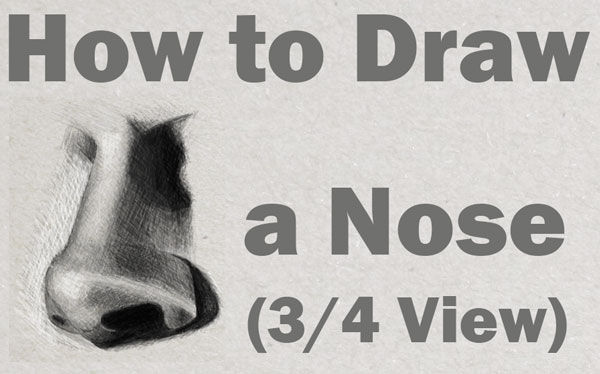

Here is a step by step tutorial for drawing realistic noses in 3/4 view with pencils / graphite pencils. “3/4 view” or “angle” means that the face is turned slightly to the side, but not all the way. Shading is a vital part of making a nose look realistic, and this tutorial will show you step by step how to shade the nose properly. This drawing method is called The Loomis Method (It’s an old book, but you can get it here if you really want it.)
(1) Graphite pencils are optional but preferred. I got this cheaper set of graphite pencils and I actually like them a lot.
(2) Gray paper is optional. It is much easier to draw a tinted paper when it comes to facial features. Here is a good gray-toned drawing pad.
(3) Eraser. I usually use types of erasers. I use (a) A white drawing eraser and (2) Kneaded eraser
[ad#draw]
I find that it is easier to draw people’s faces and facial features on gray or tan paper. You don’t have to though. This is optional.
(Steps 1-5) The first step is drawing guidelines for the nose. These guidelines will help you figure out where to draw the lines of the nose, as well as where to shade. Even though my guidelines are in blue, you should either draw them with a pencil or an HB graphite pencil. Draw these lines as lightly as possible as they will be erased later on.
You should lighten these lines as much as you can with an eraser. I have to keep my lines darker so that you can still see them.
(Steps 6-11) Let’s draw the features of the nose. Use the guidelines to help you figure out where to place them.
(Step 12) Lighten these lines with an eraser. A kneaded eraser works well, but any eraser will do. You want to lighten these lines so that you can just barely see them.
(Step 13) Now we will start adding shadows. Let’s first start shading the darker shadows. I use a crosshatch method where I draw lines in different directions on top of each other. If using graphite pencils, use a 2B.
(Step 14) Continue to add the darker shadows.
(Pro Tip) When going from dark to light or vice versa, try to make a gradient by getting the values to almost match up. Do this by lightly drawing more lines until it is almost as dark as the line next to it.
(Step 15) Now let’s add some mid-tones and lighter shading. If using graphite, use an HB pencil.
(Step 16) We are going to go pretty dark here, so either press down very hard with your pencil or use a 4B or higher graphite pencil.
(Step 17) Try to shade to form gradients. Do a bit of crosshatching below the dark shadow to make it fade out a bit. Shadows rarely have just a hard edge.
(Step 18) Continue with the shading.
(Steps 19-21) Continue adding more dark shading. The more contrast you get, the better.
(Step 22) I used a white pencil to add some highlights to the center of the nose. I started with gray paper, so I can do that. If you have white paper, just use an eraser to erase out a highlight.
Now you are done. I hope that your nose turned out great.
Technorati Tags: noses, nose, 3/4 view, portraits, facial features, realistic, loomis method, how to draw a nose, how to draw noses, realistic noses, shading noses, how to shade a nose
Today, I'll show you how to draw a cartoon girl pointing at herself with step-by-step…
Today, I'll show you how to draw a crying cute little cartoon guy who is…
Today, I'll show you how to draw an adorably super-cute cartoon owl on a witch's…
Today I will show you how to draw a super cute baby-version of Winnie The…
Today I'll show you how to draw the famous Pusheen cat from social media, such…
Today I'll show you how to draw this super cute chibi version of Deadpool from…